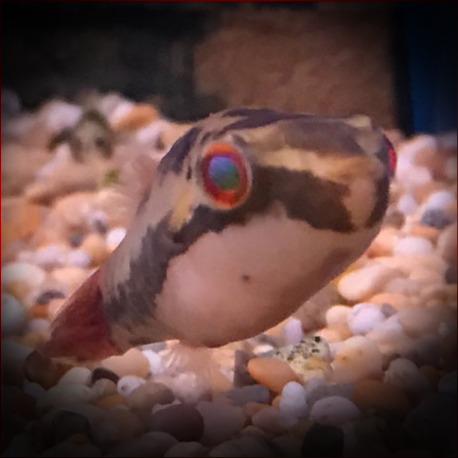More info
Datasheet
| Minimum Tank Size | 60 litres / 15.85 US gallons |
| Maximum Size | 4.5cm / 1.77inches |
| Temperature | 20°C / 68.00°F - 28°C / 82.40°F |
| Hardness | 2.02dgH / 36ppm - 12.05dgH / 215ppm |
| pH | 6.0-7.5 |
General Description
The Red-Tailed Redeye Puffer (Carinotetraodon Irrubesco) is a unique and uncommon species within the aquarium hobby. Belonging to the Tetraodontidae family, this puffer is known for its distinctive red dorsal and caudal fins in mature males. They are secondary freshwater fishes, with most members exclusively found in marine environments. These puffers are often referred to as "red-eyed puffers" and have distinguishing characteristics that separate them from other members of their genus.
Aquarium Setup
The Red-Tailed Redeye Puffer requires a well-decorated aquarium setup with driftwood roots or branches, abundant aquatic plants (including floating varieties for shade), and dried leaf litter to enhance the natural environment. It is vital to provide ample cover, as well as microbe colonies from the leaf litter, which can serve as an essential food source for fry. Maintaining stable water conditions with a temperature range of 20-28°C, pH of 6.0-7.5, and hardness between 36-215ppm is crucial for their well-being (see table).
Behaviour
This species is noted to be less aggressive than some of its genus counterparts; however, it is recommended to keep them alone or with peaceful schooling cyprinids of a suitable size to avoid competition or threats. While not highly gregarious, males can exhibit territorial behavior. Group housing is possible with ample space and hiding spots provided.
Feeding and Diet
Red-Tailed Redeye Puffers do not have true teeth but possess four fused toothlike structures that grow continuously. Their diet should consist of shelled invertebrates like snails, small crab legs, cockles, and aufwuchs, along with chopped shellfish, small earthworms, and live or frozen larvae. Dried products should not be the primary diet, although hard pelleted formats can be beneficial.
Reproduction & Dimorphism
Breeding in captivity has been documented for this species. Males display territorial behavior during courtship, and after spawning, the male may prey on the eggs. Females and males exhibit distinct sexual dimorphism in body coloration and fin markings, with males displaying red dorsal and caudal fins, while females have paler bodies with different striping patterns and markings.
Habitat and Distribution
Endemic to Indonesia, the Red-Tailed Redeye Puffer inhabits the lower Banjuasin River basin in South Sumatra and the Sambas River drainage in West Kalimantan. It is typically found in murky brown water with a pH around 6.0, exclusively among submerged riparian vegetation. Other fish species sharing its habitat include Rasbora tornieri, R. bankanensis, and Doryichthys deokhatoides.

